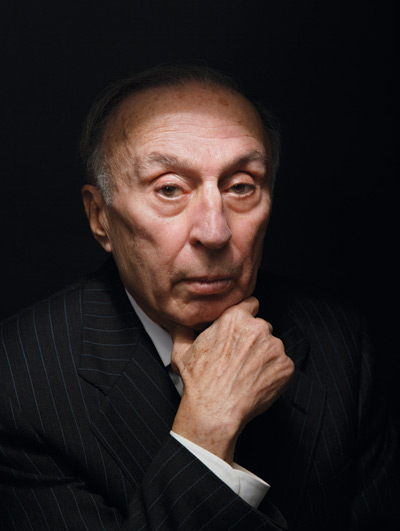Vince Salandria: The JFK Conspiracy Theorist
THREE YEARS AGO, Vince Salandria got a phone call from Arlen Specter, a man he didn’t know. Salandria had been in the Senator’s company only once before, but that was almost a half-century earlier, at a public event. When he called, Specter wasn’t running for anything—he had recently been voted out of office. All he had was a simple request of Salandria, who was 83 years old, a retired Philadelphia school-system lawyer: Would you have lunch with me? They eventually met at the Oyster House, on Sansom Street in Philadelphia. The lunch would turn out to be one of strangest meetings of Salandria’s life.
Vince is a man of high energy; he’s still doing pro bono lawyering in labor relations for the city’s schools. He’s small—all of 137 pounds—with a large balding head that narrows toward his jaw. He has an impish smile, and it would be easy to call him cute. But he isn’t, by nature, impish or cute—Vince is intense. And that was especially true when, as a young man, he attended an event held in Arlen Specter’s honor.
In October 1964, the Philadelphia Bar Association invited Specter, then a young prosecutor in the D.A.’s office, to speak about his work as an investigator for the Warren Commission, which had been formed to come up with a definitive answer to who assassinated President John F. Kennedy. Specter was assigned to figure out the basic logistics of the shooting: how many shots, how many gunmen, where did the bullets come from? The commission’s report had just come out, declaring Lee Harvey Oswald the lone killer, and the bar association had Specter address about 150 people one evening in a City Hall courtroom. Afterward, he asked if there were any questions.
Vince Salandria—who in 1964 was a history teacher at Bartram High School in Southwest Philly—stood up that night in City Hall and said he had some questions. Though really, his questions were more like statements. He said that Specter’s analysis—specifically, that a bullet had gone through the President’s neck and into Texas Governor John Connally in front of him, where it penetrated his back, smashed his right wrist, wounded his thigh, and then ended up on a gurney in a Dallas hospital in pristine condition—was a fabrication. An impossibility. An absurdity. A concoction that amounted to fraud.
Vince stood up and said that to Arlen Specter, back in 1964, before anyone else had. How could Specter come to a conclusion that was so clearly and patently wrong?
Specter was taken aback, though he remained calm. Things did get a bit testy when Vince said the commission owed it to the public to reenact “the performance of Oswald” with a rifle on moving targets; Arlen Specter wondered whether Vince would have them kill a man in order to perform a ballistics test. Vince ignored the joke; he didn’t find murder funny. Dummies, he said to Arlen Specter. Dummies could be used.
Some lawyers came up to Vince Salandria when it was over and told him he should write up his critique, that it might be important. If that bullet didn’t do what Specter said it did—travel through the President and then take a circuitous route in Connally—there had to be a second gunman, and the assassination was then a conspiracy. Which would make the Warren Commission’s lone-gunman conclusion utterly wrong.
Vince went home that night and wrote his analysis, and the first detailed critique of Specter’s Magic Bullet Theory appeared in Philadelphia’s Legal Intelligencer two weeks later.
That was just the beginning. Vince quickly became part of a small, loose collective of Warren Commission debunkers. He wrote more articles and shared his thinking with fellow researchers; Jim Garrison, the New Orleans district attorney portrayed in Oliver Stone’s JFK, asked Vince to edit one of his books. Vince is front and center in Calvin Trillin’s 1967 New Yorker portrayal of conspiracy researchers. He made speeches. And if anything, his conclusion—what he surmised almost immediately when the President was murdered—has only grown firmer over the years: Kennedy was assassinated by the CIA and the U.S. military, not Lee Harvey Oswald.
Specter, meanwhile, went on to become … Arlen Specter. The bulldog senator who brought us the infamous battles over Robert Bork and Anita Hill. Specter never seemed to shy away from a good fight, and throughout his 30-year reign in the Senate, the Magic Bullet Theory followed him everywhere. It became theater at every public event and campaign stop where Specter fielded questions, the Senator pantomiming the movement of Commission Exhibit 399 through the President’s neck, out his tie knot in front and so forth. The questions never abated; his response was always the same: one gunman.
Specter would realize early on that he could thwart a lot of public animosity by asking a Magic Bullet skeptic if he had actually read the Warren Commission Report. Almost always, the answer was no.
But Vince Salandria had read it. He read the entire report—all 888 pages—within a couple of weeks of it coming out. So he was ready for Arlen Specter at the meeting in City Hall back in 1964.
The two men had never discussed that night when Vince accused Specter of fraud—they had never even had a conversation before Specter called Vince out of the blue to ask him to lunch. They met in January 2012 at the Oyster House, one year after Specter’s five terms in the Senate were over. Later that year, Specter would be hit by a third round of cancer. By that October, he was dead.
At their lunch, Arlen Specter had a question for Vince Salandria.




